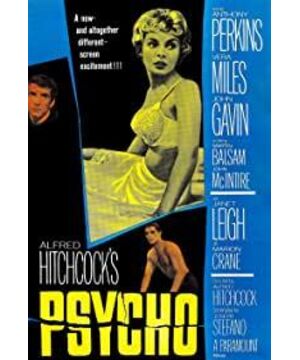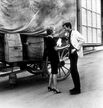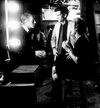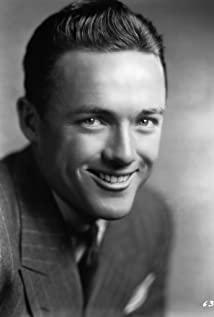· The fear of the movie · The shades of light and shadow · The twists and turns of the plot · The horror and harshness of the soundtrack · The murder in the bathroom · The impressive details. "Scary" is the second very fat movie I watched, and the first one I watched was "Rear Window". At that time, I just thought that the suspense films of the old age should not be very scary, so I tried to watch "Scary" by myself, and finally found that I was wrong, and I was frightened by a few clips in the movie. The first time I watched "Scary", I should be very directly frightened by the several classic shots in it. However, I watched the movie a few times later, and every time I found new highlights in the movie, I even started to be scared. . The 1960 movie was deliberately made into black and white by Xi Pang. The first is because Xi Pang doesn't have enough funds to make black and white films, and the second is because Xi Pang said that he didn't want to make the film too bloody. Yes, "Scary" is indeed not bloody in other horror films, but it is not its characteristic to see blood. It uses the characteristics of sound, light and shadow to create a horrible and cohesive atmosphere, including stretching of the lens, looking up and looking down. Angle of the lens.
The plot is suspenseful and thought-provoking. From the very beginning, Xi Pang used a pretense. The heroine Marion rolled up the company’s 40,000 cash and was about to change the car to escape. She met the police on the road. I still remember a barrage saying "I think something will happen with this money." So even the barrage was fooled by Xi Pang from the beginning, thinking it was the "horror" of the heroine escaping from the police, but later, when the heroine was resting in a hotel, the style of painting began to change, and the movie began to slow down. Slowly pushing towards the climax, Norman, an innkeeper who looked very gentle, told about his mother and Marion, and invited Marion to have dinner with him. He looked like a very filial child, everything was normal. As a result, when Marion went to take a bath, it turned into a murder. When the murderer walked out the door, the camera showed a skirt of the skirt, which made us think it was Marion killed by Norman's mother, so we started to sort out the movie again. The plot clues are played back in the mind. As a result, Marion’s sister Lila found out that Norman’s mother passed away 10 years ago. At this time, we shifted our eyes from Norman’s mother to Norman’s body. Only after the truth became clear did we know that Norman had schizophrenia. Sometimes he He can talk to others normally. Sometimes he wears his mother's clothes and dresses up as his mother. Sometimes he has a split personality. He can imitate his mother's voice and talk to himself, and he is also a murderer. Bernard Herrmann is the person who wrote the soundtrack for this movie, and "The Cry" is one of the pinnacle trilogy he collaborated with Hitchcock. The soundtrack uses a symphony as the title, and the violin solo as the climax. Every climax part of the violin repeats the harsh sound octave high, just like you turn off the light at night, let the dark screen of the computer weakly illuminate the room, when the sound of the violin in "The Bathroom" suddenly comes out What can you do besides screaming when you scream?
And the "bathroom murder" in the movie has become a classic. Xi Pang seems to like French suspense films very much. He uses a technique called montage in it. Montage means "cutting" in French. The murder lasted only 48 seconds. It is said that 78 shots were switched. From the lens, it can be seen that the murderer did not pierce the heroine's body with every knife, but Xi Pang cleverly used the splicing shots. , With the horrifying violin, you can feel that the flesh can be torn apart. Moreover, I mentioned earlier that the whole movie was made into black and white. Another point is that Xi Pang said, "What you see is not the disgusting way of death, but the emotions brewing before death." In the end, there are two details in this movie that impressed me. The first is that Norman, dressed as a mother, was about to push the body and the car into the swamp after killing Marion. He looked at the car and the body slowly. He has been sucking his fingers while sinking into the swamp. This unconscious habitual action reflects Norman's nervousness and anxiety when dealing with the corpse. He didn't smile slightly strangely until the car and the corpse were completely sunk in the swamp. The second is when Marion’s sister Lila secretly went to Norman’s home to investigate. When Lila walked to Norman’s mother’s room, the movie gave a shot of Norman’s mother’s bed. The bed showed a recessed. The shape of a person can tell that someone has stayed in bed for many years. After reading it, think about it again. After Norman killed his mother a long time ago, he kept his mother's body, so this is Norman before. His mother, who has been "bed-ridden" for many years, is extremely terrified to think about it.
· It is said that the string accompaniment of Eleanor Rigby, a song from the Beatles' 1966 album "Revolver", was inspired by the soundtrack of "Scary". · The last shot of the movie is Norman rolls his eyes up and stares at the camera. This kind of close-up is called "Kubrick's Gaze" by them, and it uses the look of the eyes to create anxiety. Although it was not the first Kubrick to use, this close-up was used many times in films directed by Kubrick.
View more about Psycho reviews











